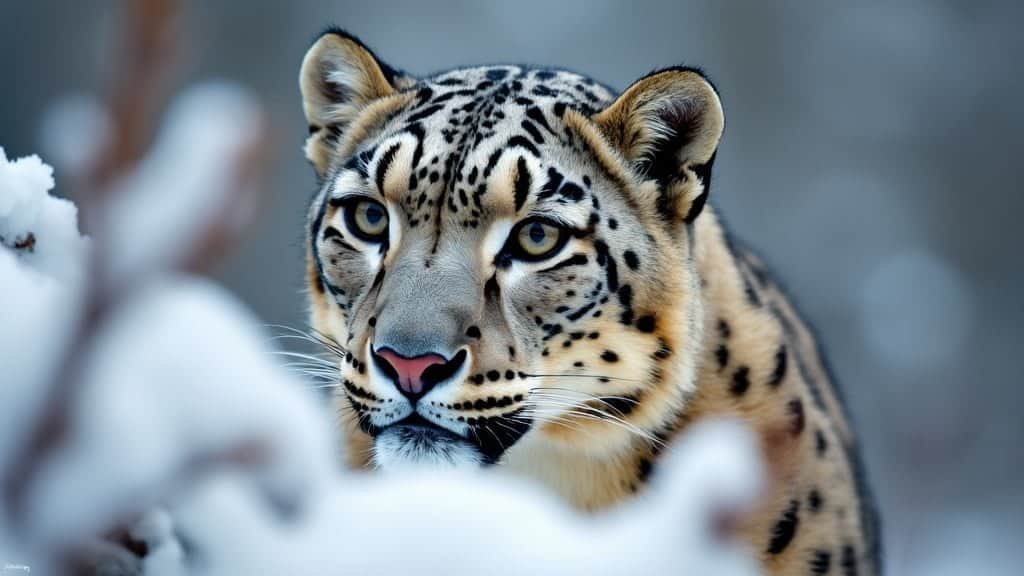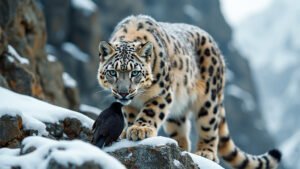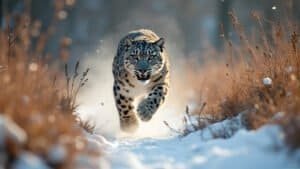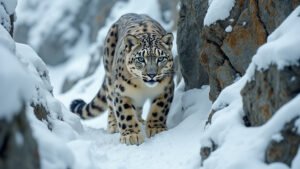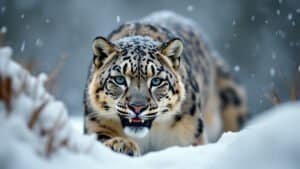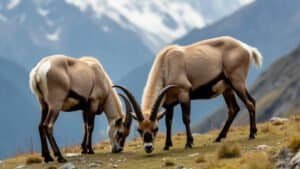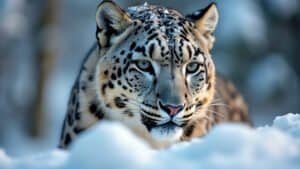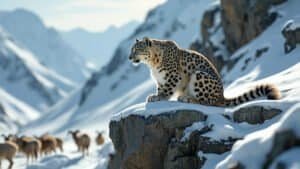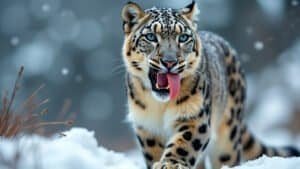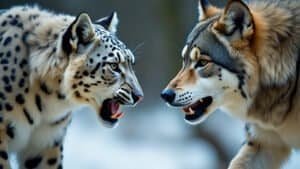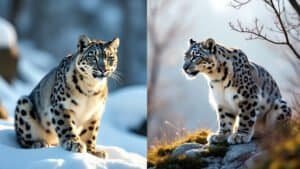Introduction
Snow leopards, the elusive big cats of the mountainous regions of Central and South Asia, have adapted their diet remarkably based on seasonal availability
This article explores the primary prey of snow leopards in winter, their summer diet, and how the availability of prey changes with the seasons. We will delve into the adaptations that allow snow leopards to hunt efficiently year-round and the impact of their diet on their overall survival
Understanding these aspects highlights the resilience and adaptability of snow leopards in their harsh natural habitats
Primary Prey of Snow Leopards in Winter
Snow leopards are well-adapted to the harsh winter conditions of their mountainous habitats
During the colder months, these predators rely on larger prey to meet their nutritional needs. Understanding what snow leopards hunt in winter, and how they do so, sheds light on their survival strategies in some of the world’s most unforgiving environments
Main Winter Prey
In winter, snow leopards primarily hunt large herbivores. One of their main prey species is the blue sheep, also known as bharal (Pseudois nayaur). These sheep are well-adapted to the steep and rocky terrains that snow leopards inhabit
The blue sheep’s population is crucial for snow leopards, providing them with a steady food source during the colder months. Studies have shown that blue sheep constitute up to 40-60% of the snow leopard’s diet in some regions (Schaller et al., 1988)
Another significant winter prey is the Siberian ibex (Capra sibirica), a wild goat found in mountainous areas. The ibex, with its impressive climbing abilities, is a challenging but rewarding target for snow leopards. These large herbivores provide essential calories and nutrients needed to sustain the leopards through the winter
Additionally, snow leopards may prey on argali sheep (Ovis ammon), which are the largest wild sheep in the world, and the Himalayan tahr (Hemitragus jemlahicus), known for their agility and strength
Hunting Techniques in Snow
Hunting in snowy conditions presents unique challenges, and snow leopards have developed specialized techniques to succeed. Their powerful legs and large paws act like natural snowshoes, distributing their weight and allowing them to move silently across the snow
This stealth is crucial for approaching prey undetected. Snow leopards are ambush predators, relying on cover and the element of surprise. They often stalk their prey from above, using rocky outcrops and ridges to remain concealed until the last moment
The snow leopard’s thick fur provides excellent insulation, allowing them to withstand freezing temperatures while lying in wait for their prey
Their long tail aids in balance and serves as a blanket to protect their faces during rest periods. Once a snow leopard spots its target, it uses its powerful hind legs to launch an attack, capable of leaping up to 50 feet in a single bound (McCarthy et al., 2005)
Nutritional Value of Winter Prey
Large prey like blue sheep and ibex provide high-calorie meals that are essential for snow leopards during the winter
The meat of these animals is rich in protein and fat, crucial for maintaining the leopard’s energy levels in cold weather. Consuming a single large herbivore can sustain a snow leopard for several days, reducing the frequency of hunts and conserving energy
Scientific studies have shown that the fat content of winter prey is particularly important. Fat provides more than twice the energy per gram compared to protein or carbohydrates, making it a vital component of the snow leopard’s diet. By consuming prey with high-fat reserves, snow leopards can build up their own fat stores, which are critical for surviving periods of food scarcity and extreme cold
Furthermore, large prey animals often contain essential vitamins and minerals that are not available from smaller prey. These nutrients support various physiological functions, including reproduction and immune system health, ensuring the snow leopards remain in peak condition
Summer Diet of Snow Leopards
As the seasons change and temperatures rise, the availability of prey for snow leopards also shifts. During the warmer months, snow leopards adapt their diet to include smaller animals, reflecting the dynamic nature of their high-altitude habitats
Examining the summer diet of snow leopards provides insight into their remarkable adaptability and survival strategies
Common Summer Prey
In summer, the abundance of large herbivores like blue sheep and ibex diminishes as these animals move to higher altitudes or different regions to find suitable grazing grounds
Consequently, snow leopards turn to smaller prey to fulfill their dietary needs. Marmots, particularly the Himalayan marmot (Marmota himalayana), become a significant part of their diet. These large ground squirrels are abundant in alpine meadows and provide a reliable food source during the summer
Other small mammals, such as pikas (Ochotona spp.), hares, and rodents, also feature prominently in the summer diet of snow leopards. Pikas, in particular, are widespread across the snow leopard’s range and are relatively easy to catch. Birds, including snowcocks and chukars, add variety to the diet and provide additional nutritional benefits
Adaptations for Hunting Smaller Animals
Hunting smaller prey requires different tactics and adaptations compared to the pursuit of large herbivores
Snow leopards utilize their keen sense of sight and hearing to locate these more elusive targets. Their stealth and patience remain critical, as they must approach quietly and quickly to catch fast-moving animals like marmots and pikas
The physical agility of snow leopards plays a crucial role in hunting smaller prey. Their flexible spine and strong hind limbs allow them to make swift, precise movements necessary for catching nimble animals. Unlike the ambush strategy used for larger prey, hunting smaller animals often involves more active chasing and pouncing
Additionally, snow leopards exhibit behavioral adaptations to maximize their hunting success
They are known to hunt at dawn and dusk, when their prey is most active, aligning their hunting efforts with the peak activity periods of marmots and other small mammals. This crepuscular hunting strategy increases their chances of encountering and capturing prey
Impact of Summer Diet on Health
The shift to a diet primarily composed of smaller animals has several implications for the health and well-being of snow leopards
While smaller prey may not provide the same caloric density as large herbivores, they offer other nutritional advantages. Small mammals and birds are rich in protein and essential nutrients, supporting the metabolic and physiological needs of snow leopards during the warmer months
One significant benefit of a summer diet is the reduced risk of starvation. Smaller prey animals are generally more abundant and easier to catch than large herbivores, ensuring a more consistent food supply. This consistent access to food is particularly important for female snow leopards that may be nursing cubs or preparing for the next breeding season
However, relying on smaller prey also means that snow leopards must hunt more frequently to meet their energy requirements. This increased hunting activity can lead to higher energy expenditure, which must be balanced by the caloric intake from their prey
Fortunately, the abundance of small mammals and birds during summer helps mitigate this challenge, allowing snow leopards to maintain their health and strength
The seasonal dietary shift also highlights the snow leopard’s ecological role as both a predator of large ungulates and a regulator of small mammal populations. By preying on marmots, pikas, and other small animals, snow leopards help control their populations, which can impact the overall health and dynamics of their ecosystems
Seasonal Changes in Prey Availability
The availability of prey for snow leopards changes with the seasons, directly influencing their hunting patterns and diet. Understanding these seasonal variations in prey availability is crucial to comprehending the adaptive strategies of snow leopards in their mountainous habitats
Environmental Factors
Seasonal changes in the environment play a significant role in determining the availability of prey for snow leopards
During winter, harsh weather conditions and heavy snowfall limit the movement and distribution of prey animals. Large herbivores like blue sheep, ibex, and argali tend to congregate in lower altitudes where food is more accessible, making them more vulnerable to predation by snow leopards
In contrast, the summer months bring milder weather and increased vegetation growth, allowing prey animals to disperse to higher altitudes and different regions in search of fresh grazing grounds. This dispersal makes large prey less accessible to snow leopards, necessitating a shift to smaller, more readily available prey like marmots, pikas, and birds
Migration Patterns of Prey
Migration patterns of prey animals also influence snow leopard diet and hunting behavior. Many large herbivores undertake seasonal migrations to optimize their access to food resources
For instance, blue sheep and ibex may migrate to higher elevations during the summer to graze on alpine meadows, while descending to lower altitudes in winter to avoid deep snow and find food
These migratory movements create a dynamic prey landscape for snow leopards. In winter, the concentration of large prey in specific areas provides hunting opportunities, while summer migrations reduce the availability of these animals, prompting snow leopards to focus on smaller, non-migratory prey species
Understanding these migration patterns helps in predicting the dietary adjustments snow leopards make throughout the year
Seasonal Diet Variations
Seasonal variations in prey availability lead to significant changes in the diet composition of snow leopards
During winter, the diet is dominated by large herbivores, providing the necessary calories and nutrients to sustain the leopards through the cold months. The high-fat content of winter prey is particularly crucial, as it helps snow leopards maintain their energy reserves and survive periods of food scarcity
In summer, the diet shifts to smaller mammals and birds, reflecting the reduced availability of large prey. This dietary shift requires snow leopards to adapt their hunting techniques and increase their hunting frequency to meet their nutritional needs
The inclusion of a diverse range of prey items in their summer diet ensures that snow leopards receive a balanced intake of proteins, fats, vitamins, and minerals essential for their overall health
Research indicates that these seasonal dietary variations are not just a survival strategy but also influence the reproductive success of snow leopards
Females require sufficient nutrition to support pregnancy and nursing cubs, making the availability of prey critical during the breeding season. Seasonal prey availability, therefore, plays a pivotal role in the population dynamics and conservation of snow leopards
Adaptations for Seasonal Hunting
Snow leopards have evolved various physical and behavioral adaptations that allow them to effectively hunt and survive in the extreme conditions of their mountainous habitats. These adaptations are particularly crucial for coping with the seasonal variations in prey availability and environmental conditions
Physical Adaptations
Snow leopards possess several physical traits that enhance their hunting capabilities in both winter and summer. Their powerful hind legs and large, well-padded paws enable them to navigate and remain stealthy on rocky terrains and deep snow
These paws act like snowshoes, distributing their weight and preventing them from sinking into the snow, which is particularly useful when stalking prey in winter
The snow leopard’s thick, insulated fur provides excellent protection against the cold. This fur also has a camouflage pattern that blends with the rocky and snowy environment, making it easier for them to approach their prey undetected
Their long, muscular tails help with balance while maneuvering through rugged landscapes and serve as a blanket to protect their face and nose during rest periods in the cold
Behavioral Adaptations
Behaviorally, snow leopards exhibit several adaptations that enhance their hunting success across different seasons. During winter, when prey is more concentrated in specific areas, snow leopards rely on their ambush hunting strategy
They use rocky outcrops and ridges to stay hidden and patiently wait for the right moment to attack. This method conserves energy, which is crucial in the resource-scarce winter months
In summer, snow leopards adapt by becoming more opportunistic hunters. With the dispersal of large prey, they focus on smaller mammals and birds that are more abundant. This shift requires increased hunting frequency and agility, as catching smaller prey often involves more active chasing and pouncing
Snow leopards are known to hunt during dawn and dusk when their prey is most active, maximizing their chances of success
Survival Strategies
Snow leopards have developed a range of survival strategies to cope with the fluctuating availability of prey and the harsh environmental conditions
One key strategy is their extensive home range, which can cover up to 80 square miles. This large territory allows them to follow the movements of migratory prey and exploit different food resources throughout the year
Another survival strategy is their ability to fast for extended periods when prey is scarce. Snow leopards can survive on minimal food intake, relying on their fat reserves built up during periods of abundance. This metabolic adaptation is vital for enduring the leaner months of winter when hunting success may be lower
Additionally, snow leopards exhibit territorial marking behaviors, such as scraping the ground and spraying urine, to communicate with other leopards and establish their presence in a region. This territoriality helps reduce conflicts and competition for food, ensuring better access to available prey
These physical and behavioral adaptations highlight the snow leopard’s remarkable ability to thrive in one of the planet’s most challenging environments. Their survival depends on a complex interplay of hunting skills, environmental awareness, and physiological resilience, allowing them to maintain their position as apex predators in the mountainous regions of Central and South Asia
Impact of Diet on Snow Leopard Survival
The diet of snow leopards is critical to their survival, influencing their health, reproductive success, and long-term viability. By examining the nutritional requirements of snow leopards and how their diet affects their overall survival, we gain a deeper understanding of the challenges these elusive predators face in their natural habitats
Nutritional Requirements
Snow leopards require a diet rich in proteins and fats to sustain their energy levels and overall health. Large herbivores, such as blue sheep and ibex, provide the necessary caloric intake and essential nutrients
These prey animals are particularly important in winter when the leopards need to build and maintain fat reserves to survive the cold and periods of food scarcity
Protein is crucial for muscle maintenance and growth, while fat provides a concentrated energy source that is vital during times of limited food availability. The high-fat content of winter prey helps snow leopards maintain their energy levels and supports their physiological functions, including reproduction
Role of Diet in Reproduction
The diet of snow leopards directly impacts their reproductive success. Adequate nutrition is essential for females to support pregnancy, lactation, and the growth of their cubs. During the breeding season, which typically occurs in late winter to early spring, females must have access to sufficient prey to ensure they are in optimal condition for mating and raising offspring
Studies have shown that female snow leopards with access to abundant prey are more likely to produce healthier and stronger cubs. The nutritional status of the mother influences the survival and growth rates of her cubs, making the availability of prey a critical factor in the population dynamics of snow leopards
Long-term Survival
The long-term survival of snow leopards is closely tied to their ability to adapt their diet to the changing availability of prey
The seasonal shifts in prey availability require snow leopards to be flexible and opportunistic hunters. Their ability to switch from large herbivores in winter to smaller mammals and birds in summer is a testament to their adaptability and resilience
However, this adaptability is challenged by factors such as habitat loss, climate change, and human-wildlife conflict
Changes in land use and agricultural practices can reduce the availability of natural prey, forcing snow leopards to venture closer to human settlements in search of food. This often leads to conflicts with livestock herders, resulting in retaliatory killings and further threatening snow leopard populations
Climate change also poses a significant threat to the prey base of snow leopards. Alterations in temperature and precipitation patterns can affect the distribution and abundance of prey species, disrupting the delicate balance of the ecosystem
For example, changes in snowfall patterns can impact the migratory routes and population dynamics of large herbivores, making them less predictable and harder to hunt
Conservation Implications
Understanding the dietary needs and adaptations of snow leopards is crucial for developing effective conservation strategies. Protecting their natural habitats and ensuring the availability of prey are essential for their survival
Conservation efforts must focus on mitigating human-wildlife conflicts, preserving migratory corridors for prey species, and addressing the impacts of climate change on the ecosystems snow leopards inhabit
Community-based conservation programs that involve local herders and communities in snow leopard conservation have shown promise. By promoting sustainable livestock management practices and providing compensation for livestock losses, these programs can reduce conflicts and foster coexistence between humans and snow leopards
Research and monitoring of snow leopard populations and their prey are also vital. Continued studies on prey availability, dietary patterns, and the health of snow leopard populations provide valuable data that can inform conservation policies and actions
Conclusion
Snow leopards exhibit remarkable adaptability in their diet, reflecting the seasonal availability of prey in their mountainous habitats. During winter, they primarily hunt large herbivores such as blue sheep and ibex, which provide the necessary calories and nutrients to endure the harsh conditions. In summer, the diet shifts to smaller mammals and birds, requiring increased hunting frequency and agility
Seasonal changes in prey availability, driven by environmental factors and migration patterns, necessitate flexible hunting strategies and behaviors. Physical adaptations, such as powerful hind legs and large paws, and behavioral strategies, including ambush hunting and opportunistic feeding, enable snow leopards to thrive in diverse conditions
The diet of snow leopards significantly impacts their health, reproductive success, and long-term survival
Adequate nutrition is vital for maintaining energy levels, supporting reproductive functions, and ensuring the growth of cubs. However, challenges such as habitat loss, climate change, and human-wildlife conflict threaten their prey base and survival
Conservation efforts must focus on protecting habitats, mitigating conflicts, and addressing climate impacts to ensure the continued survival of these elusive predators. Understanding and supporting the dietary needs of snow leopards are essential components of effective conservation strategies
